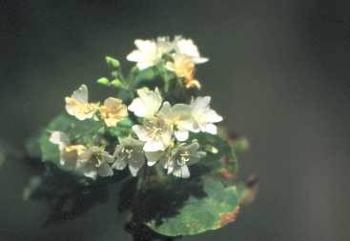Dombeya autumnalis
Dombeya autumnalis I.Verd.
Family: Malvaceae
Common names: autumn dombeya, autumn wild pear (English); rotsdrolpeer (Afrikaans)
SA Tree No: 468
Introduction
This is another attractive shrub for the garden.

Description
Description
Some weeks ago another dombeya was featured, the pink wild pear, D. burgessiae, which had large, velvety leaves and heads of pink to white flowers. Dombeya autumnalis has small leaves and delicate, creamy white heads of little flowers which appear in a burst of blossom which is a feature of Dombeya. These have a sweet scent and, like other wild pears, the blooms retain their shape, but change colour to reddish brown and remain on the plant, while the seed capsules form in the centre. The dry petals help to disperse the seed later on when they act as wings to float the seed capsules away.
Distribution and habitat
Distribution description
D. autumnalis is a small, often multistemmed, tree up to 4.5 metres which grows in the Lydenburg and Ohrigstad areas in Mpumalanga and Northern Province. It is commonly seen along the Abel Erasmus Pass where it grows in the rocky, wooded hillsides. It also occurs in riverine bush. The area in which it occurs is restricted to this small distribution, and its occurrence may be related to the dolomite rock formations in that area.
Derivation of name and historical aspects
History
The name of this genus honours Joseph Dombey, a botanist who worked in Peru and Chile. The specific name, autumnalis, indicates the flowering time of this particular species.
Growing Dombeya autumnalis
Grow
D. autumnalis is not commonly available to gardeners but would make a pretty garden subject with its lovely smooth grey stems. One could plant the common wild pear, Dombeya rotundifolia, as a herald of spring, and the autumn wild pear to announce winter! Like other Dombeya spp. it can be propagated from seed in spring in deep seed trays of good, fine seedling mix, lightly covered and kept moist. The seedlings should be transplanted into small nursery bags once the true leaves have formed, and should be given protection from heat and sun until they are hardened off.
Credits
Alice Aubrey
Walter Sisulu National Botanical Garden
May 2001
Plant Attributes:
Plant Type: Tree
SA Distribution: Limpopo, Mpumalanga
Soil type: Metal-rich
Flowering season: Late Summer, Autumn
PH: Alkaline
Flower colour: White, Cream
Aspect: Full Sun
Gardening skill: Average
Special Features:
Horticultural zones







Rate this article
Article well written and informative
Rate this plant
Is this an interesting plant?
Login to add your Comment
Back to topNot registered yet? Click here to register.